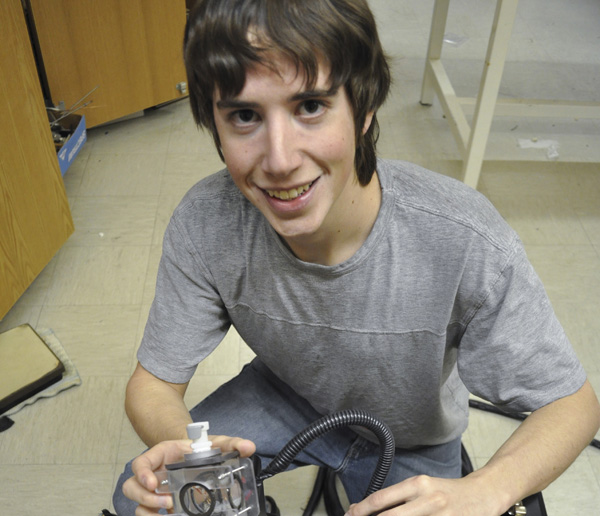USU continues to put projects into space
USU’s GAS Team is putting forward a new project aimed to be launched into space by NASA that will lead to new understanding of the process of nucleate boiling in microgravity.
The USU GAS team (the get away special team), according to its Web site, is a group of mostly undergraduate students who get involved in space research any way they can and work on the projects mainly on a volunteer basis and receive little or no voluntary aid.
There are more than 11 student members working on the project called FUNBOE (Follow Up Nucleate Boiling Onboard Experiment), aimed to further study the effects of boiling in space. Of those 11, nine undergraduates will have the opportunity to work in-field with NASA and some will be launched into space with FUNBOE.
Justin Koeln, mechanical engineering major and the team’s technical lead, said this research presents new insight to how bubbling occurs, such as when it gets into space. This June, he said, nine members of the team will go to Houston to test their product. The project is said to cost up to $35,000, with funding from sponsors, such as space companies and the College of Engineering.
The project revolves around nucleate boiling, which, according to Troy Munro, the team contact with NASA, is the same as the boiling of the small bubbles that form before the water comes to a complete boil.
According to Koeln, to boil the water in space, the students will use small metal and plastic rods that will enable the boiling bubbles to expand and act as insulators in space, enabling the students to keep the water from separating.
“On Earth, the bubbles will go to the surface … but in space, there really is no top, there’s no buoyancy to cause the bubbles to go to anywhere,” Koeln said. “So early on, you know, the first experiments scientists thought the bubbles wouldn’t go anywhere.”
Because the process of boiling is to move heat around, Koeln said, this insulator-in-space will prevent heat from moving around and instead surrounding the wires installed. The boiling is a very vital source for cooling the wire.
“Currently, on Earth, basically all of our electric generation processes require boiling at some point, whether it be coal, plant, creating heat then boiling water or nuclear plant, creating heat then boiling water,” Koeln said. “Pretty much uses some heat to boil water, which then combines turbines to create electricity.”
Koeln said that to generate electricity water needed to be boiled, so it was considered difficult to do as it would form a huge heat bubble in space. One of FUNBOE’s purpose is to experiment if this is still possible.
In some recent experiments, Koeln said, scientists have shown that small individual bubbles can form on the wire and then depart.
Koeln said a similar experiment was tried the last time NASA shot one of GAS’ experiments into space. That time they had boiled water for more than 35 minutes. Then, he said, the bubble was able to separate from the water and the researchers were able to move the heat around.
Basically, Koeln said by taking voltage measurements and knowing what power the researchers will be putting in, they will be able to get a graph of the temperature of this wire while it is boiling. Also cameras will be installed to follow the movement of the bubbles.
GAS has also promoted FUNBOE to Logan’s school districts through its outreach program. Stephanie Peterson, physics education major at USU and in charge of the program, said GAS have been in touch with more than eight local schools reaching more than 1,000 students. She said the group talks about scientific discoveries and use demonstrations to help the students understand it better. She said the best part is getting the students interested in science.
“You have the opportunity to be at NASA as an undergraduate. It’s a great opportunity, that’s for sure,” Peterson said.
Although there are similar programs like GAS around the country, Peterson said USU has sent more objects into space than any other university. Every year, it sends a form describing its project to NASA and waits to see if it will be accepted. Koeln said this year FUNBOE was accepted.
“We ended up writing a 40-page proposal outlining every detail that we have on our experiment,” Koeln said. “We have to write a lot about the scientific content of it. They want to make sure they’re getting good scientific research out of it.”
Peterson said the researchers have been working hard and still have work to do.
“Right now we are building the floating structure and once that is complete and, once we have a structure that’s going to be stationary on the ground, and then we’re going to have a floating structure connected to it like a chain,” Peterson said. “So, the structure on the ground, and the floating structure, they’re both almost complete and then we’re going to mass produce everything.”
The nine members that are to go into space with the FUNBOE will be transported onto a plane known as the Vomit Comet. Before that, they will take a number of tests to measure their reactions to the sky and their level of oxygen.
Munro said high school students came up with FUNBOE in early 2000.
“Box Elder kids wanted to see nucleate boiling … and they wanted to see what would happen to that in space, if the bubbles would ever leave,” Munro said.
Beginning the nucleate boiling experiment was an idea that began in October of 2009. The team has since completed up to 85 percent of the project, according to Munro who hopes the experiment will be a success.
– k.del@aggiemail.usu.edu

